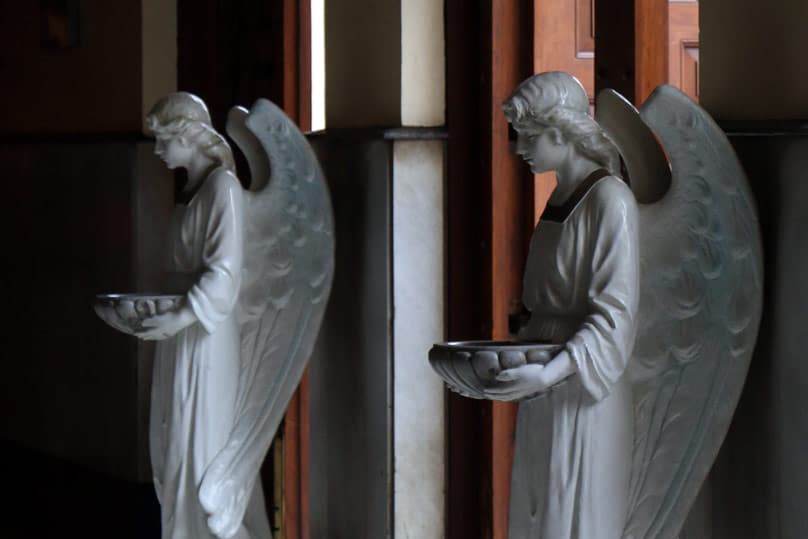
Blessing ourselves with holy water has a number of different purposes and meanings. The first goes back to the Old Testament, where those engaging in various functions in the worship of God always washed themselves with water first in order to be purified for their spiritual function.
We see this, for example, as early as the book of Exodus, where God commands Moses to make a bronze laver, or water bowl, for priests to wash themselves: “You shall also make a laver of bronze, with its base of bronze for washing. And you shall put it between the tent of meeting and the altar, and you shall put water in it, with which Aaron and his sons shall wash their hands and their feet. When they go into the tent of meeting, or when they come near the altar to minister, to burn an offering by fire to the Lord, they shall wash with water” (Ex 30:18-20). The laver on its base is very much like our holy water font, and its location before the altar is similar to the font’s location at the entrance to the church.
This practice was taken up in the early Church, where a fountain was placed in the atrium of basilicas so that the people could wash their hands before entering. One of the most well-known of these was the first-century bronze pine cone, almost four metres high, which stood near the Pantheon in Rome and was later placed in the courtyard of the first basilica of St Peter. It now stands in the Cortile della Pigna, or courtyard of the pine cone, in the Vatican Museum.
When the large atrium gave way to a smaller porch, the fountain was replaced by a smaller holy water font just inside the entrance. The use of the water was meant to be not just for an external washing but especially a purification of one’s mind and heart. So St John Chrysystom warns of those who “enter church washing their hands but not their hearts” (Hom. LXXI on St John). We too should see blessing ourselves with holy water as purifying our mind and heart.
In the ninth century, although the custom already existed before then, Pope Leo IV (847-855) ordered priests to bless and sprinkle the people with holy water every Sunday before Mass, a custom we know as the Asperges, or sprinkling. We see its meaning in one of the formulas of blessing of the water where the priest says: “Almighty ever-living God, who willed that through water, the fountain of life and the source of purification, even souls should be cleansed and receive the gift of eternal life; be pleased, we pray, to bless this water, by which we seek protection on this your day, O Lord. Renew the living spring of your grace within us and grant that by this water we may be defended from all ills of spirit and body, and so approach you with hearts made clean and worthily receive your salvation.”
In the sixteenth century St Charles Borromeo, Archbishop of Milan, issued norms for the design of holy water fonts: “The vessel intended for holy water … shall be of marble or of solid stone, neither porous nor with cracks. It shall rest upon a handsomely wrought column and shall not be placed outside of the church but within it and, insofar as possible, to the right of those who enter.”
When we bless ourselves with holy water, apart from purifying our minds and hearts we remind ourselves of our baptism and we can renew our baptismal commitment. In this sense one of the blessings of holy water says: “Blessed are you, Lord, all-powerful God, who in Christ, the living water of salvation, blessed and transformed us. Grant that, when we are sprinkled with this water or make use of it, we will be refreshed inwardly by the power of the Holy Spirit and continue to walk in the new life we received at Baptism.”
And then of course we make the sign of the cross with the water, reminding ourselves of the Cross of Christ by which we were redeemed, as well as the daily crosses we can bear in union with his.
Finally, when we say “In the name of the Father and of the Son and of the Holy Spirit” we remind ourselves of the Blessed Trinity, the central truth of our faith. So the use of holy water is not only ancient in origin but very rich in meaning.
